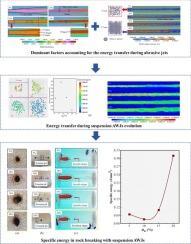基于 VOF-DEM 方法的磨料体积分数对悬浮磨料水射流能量利用率的影响
IF 4.5
2区 工程技术
Q2 ENGINEERING, CHEMICAL
引用次数: 0
摘要
悬浮磨料水射流(AWJs)破岩是磨料颗粒群的动能输送和传递。然而,由于破岩能耗较高,很难得到推广和利用。本研究重点关注 AWJs 中的能量传递率,并使用数值和实验方法对其进行了研究。采用双向耦合算法再现了磨料射流速度的振荡特性,表明能量传输率的关键不仅在于磨料的速度,还在于磨料的分布。确定了影响磨料速度和分布的不同主导因素,并提出了两个参数来解释射流演变过程中的能量传递过程。根据能量密度的演变和磨料动能与总能量的比率,确定了最佳磨料体积分数,并通过岩石破碎实验进行了验证。通过改变磨料体积分数的方法提高磨料动能与总能量之比,是提高悬浮磨料水射流破岩效率的有效方法。本文章由计算机程序翻译,如有差异,请以英文原文为准。

Effect of abrasive volume fraction on energy utilization in suspension abrasive water jets based on VOF-DEM method
Suspension abrasive water jets (AWJs) rock breaking is the kinetic energy of abrasive particle group transport and transfer. However, it is difficult to be popularized and utilized due to the high energy consumption of rock breaking. In this study, the energy transfer rate in AWJs was focused on and was investigated using numerical and experimental methods. A two-way coupled algorithm was used to reproduce the oscillation characteristics of abrasive jets velocities, indicating that not only the abrasives' velocities but also the abrasives' distribution is crucial in energy transfer rate. Different dominant factors accounting for the abrasives' velocities and distribution were identified, and two parameters were proposed to account for the energy transfer process during the jet evolution process. The optimum abrasives' volume fraction was determined based on the evolution of the energy density and ratio of abrasive kinetic energy to the total energy, which was validated by rock breaking experiments. Increasing ratio of abrasive kinetic energy to the total energy by using the method of changing the volume fraction of the abrasive is an effective method to improve the rock breaking efficiency of suspension abrasive water jets.
求助全文
通过发布文献求助,成功后即可免费获取论文全文。
去求助
来源期刊

Powder Technology
工程技术-工程:化工
CiteScore
9.90
自引率
15.40%
发文量
1047
审稿时长
46 days
期刊介绍:
Powder Technology is an International Journal on the Science and Technology of Wet and Dry Particulate Systems. Powder Technology publishes papers on all aspects of the formation of particles and their characterisation and on the study of systems containing particulate solids. No limitation is imposed on the size of the particles, which may range from nanometre scale, as in pigments or aerosols, to that of mined or quarried materials. The following list of topics is not intended to be comprehensive, but rather to indicate typical subjects which fall within the scope of the journal's interests:
Formation and synthesis of particles by precipitation and other methods.
Modification of particles by agglomeration, coating, comminution and attrition.
Characterisation of the size, shape, surface area, pore structure and strength of particles and agglomerates (including the origins and effects of inter particle forces).
Packing, failure, flow and permeability of assemblies of particles.
Particle-particle interactions and suspension rheology.
Handling and processing operations such as slurry flow, fluidization, pneumatic conveying.
Interactions between particles and their environment, including delivery of particulate products to the body.
Applications of particle technology in production of pharmaceuticals, chemicals, foods, pigments, structural, and functional materials and in environmental and energy related matters.
For materials-oriented contributions we are looking for articles revealing the effect of particle/powder characteristics (size, morphology and composition, in that order) on material performance or functionality and, ideally, comparison to any industrial standard.
 求助内容:
求助内容: 应助结果提醒方式:
应助结果提醒方式:


